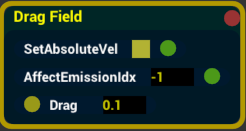Fields
Saturday, July 28, 2018 1:37 AMOverview
Fields are basically forces which get applied to the particles during simulation. A variety of fields are available that range from simple directional gravitational pull to something more elaborate like a pseudo Fast Fluid Twist Force.
Common Attributes
-
SetAbsoluteVel - Whether the field directly modifies the velocity or influences it via velocity deltas. Use the default value that is instantiated with the field, you do not have to change this value.
-
AffectEmissionIdx - The emission idx number that this field affects. Particles emitted from a source have an emission idx number that you can supply. The field itself also has one. This means only particles with the same emission idx specified in this attribute will be affected by the field, the others will be ignored. This is useful if you want certain fields to affect particles from certain sources but not others.
Gravity Field

This is the standard directional force applied in a certain direction. Use this to direct particles towards a desired direction and magnitude.
Attributes
- Gravity[X/Y/Z] - The amount of gravity force in X,Y,Z directions.
Fast Fluids Field

This simulates the twist and turns of particles passing through fluids. It does not simulate the full fluid dynamics equations and is just an approximation. However, it is easier to control and much faster to compute.
Attributes
-
Frequency - The speed at which the noise changes over time
-
Octaves - How many different noise functions/modes there are, controls the variation of the noise
-
FrequencyOctaveStep - How frequency of each octave changes with each step
-
Persistence - How much influence each octave has
-
DirectionFactor - How much of the original velocity of the particle is considered for computation. The larger the value the more likely the particles will travel in the general direction they were spanwed with
-
CurlFactor - The decides the amount of twisting motion there is in the fluids field
-
TimeMult - The multiplies the changes in the fluids field with a time multiplier, speeding up/slowing down the forces applied
-
RotateNoise - This adds rotational noise amounts to the fluids field
Wind Field

This is a node that simulates wind forces blowing on the affected particles.
Attributes
-
Angle - The general direction of the wind
-
AngleDelta - The allowed variation of the direction of the wind, with respect to the prescribed angle
-
Turbulence - How noisy the the wind function is
-
Frequency - How fast the wind function changes over time
-
Scale - This is how strong the overall wind is
-
DistributionScale - This determines how the noise of the wind is distributed over time
-
ScaleFreq - This changes how fast the magnitude of the wind grows and shrinks over time
Drag Field

A drag field removes energy from the particle system, effectively slowing the particles down.
Attributes
- Drag - A value from 0 to 1, at 1 all energy will be drained out of the moving particle